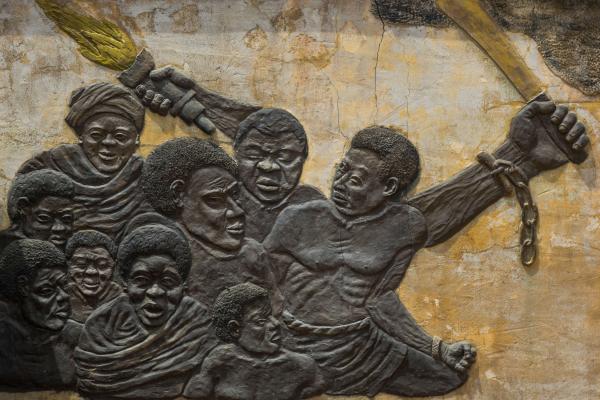At the first 2024 Republican presidential primary debate on Aug. 23, presidential hopeful Vivek Ramaswamy called for a return to involuntary institutionalization of “violent, psychiatrically deranged people” as a solution for our country’s gun violence epidemic.
His voice joins that of former Vice President Mike Pence who made a similar call at an NRA convention in April. Democrats are also pushing for the involuntary institutionalization of people: Last November, Democratic New York City Mayor Eric Adams laid out a plan for involuntary hospitalization as a solution for addressing homelessness, and Democratic California Governor Gavin Newsom recently amended his proposed $6 billion mental health bond language that would have prohibited involuntary psychiatric institutionalization. Pence, Adams, and Newsom identify as Christian.
What involuntary institutionalization fails to account for is the United States’ shameful history of institutional confinement. We have a long history of using institutions to segregate people we deem to be unfit for society or simply different. With such a fraught history and scientific evidence to prove otherwise, why do politicians from both parties continue to suggest involuntary institutionalization as an “answer” to issues surrounding intellectual and developmental disabilities (IDDs) as well as mental illness? What is to be made of the fact that several pro-institutionalization politicians identify as Christian? Is there an alternative Christian theology that emphasizes liberation instead of institutionalization?
***
In psychologist and sociologist Erving Goffman’s classic text Asylums: Essays on the Social Situation of Mental Patients and Other Inmates, he describes total institutions as spaces where groups of people are isolated from communities, subject to rigid structuring of daily routines, and are required to sleep, work, and play in the same space. These confining spaces give people little in the way of autonomy, freedom, and human rights. In the U.S., the number of these institutions grew exponentially in the first half of the 20th century, with large numbers of people being warehoused in overcrowded, understaffed, and unsanitary facilities.
It’s important to note that both IDDs and mental illnesses are socially constructed identities. This means the boundaries around what we label IDDs or mental illness are dynamic and change based on history, place, and culture. For example, while “homosexuality” and “drapetomania” (the act of enslaved people running away to free themselves) were once classified as mental illnesses, our contemporary society has progressed enough for us to recognize that those designations were homophobic and racist.
Historically, people with IDDs, mental illnesses, and so-called “socially deviant” behavior were among the groups recommended for involuntary institutionalization. This was done under the guise of protecting society. Since these conditions were considered genetically inherited and incurable, people deemed “unfit” were believed to be a threat to pass that unfitness on to subsequent generations, contributing to “racial degeneration.” Without clear diagnostic criteria, institutional superintendents and psychologists had great discretion over who could be labeled “feebleminded,” and their criteria often included a mix of factors including “crime, prostitution, pauperism, illegitimacy, intemperance and other complex social diseases.” To prevent the spread of this feeblemindedness, eugenics was proposed as a solution.
Eugenics was a popular racist and ableist pseudoscience that was presented in college classrooms and scientific conferences. Eugenics, or “good in birth,” is a theory that argues that the “racial stock” of humans can be improved in much the same way as cattle. Eugenicists proposed that this could be accomplished by encouraging the most “fit” to reproduce (positive eugenics) and discouraging or restricting the “unfit” from reproducing (negative eugenics). The merits of eugenics were lauded at state fairs, local civic groups, and churches.
While scientific support for eugenics in the United States dropped off precipitously post-WWII, the congregate institutions, which were created under the impetus of eugenics, continued to see increases in their population in the years immediately after the war — before the deinstitutionalization movement began in the 1950s. Congregate institutions were widely recommended for anyone labeled with what was then referred to as “mental retardation,” including infants and young children. Churches contributed to this stigmatization of disability. Clergy members joined the chorus of professionals recommending institutional placement for all “retarded children.” This was framed as something parents must do for the sake of the rest of the family, because “the stress of caring for a retarded child would cause grave psychiatric harm to parents and any siblings.”
Eugenicists in the early 20th century were asking the question of how to solve the “problem of the feebleminded.” We hear echoes of this sentiment today coming from politicians who, on the one hand, claim that their faith plays a major role in their lives but, on the other hand, support institutionalization. What if there is a more liberating Christian theology that can help them and society at large imagine a more just world?
Instead of seeing people as problems and forcing them to be institutionalized, we must embrace different ways of being in our own communities. As theologian John Swinton contends in Becoming Friends of Time: Disability, Timefullness, and Gentle Discipleship, we tend to assign hierarchical values to what we consider better or worse ways to interact with and serve God.
I believe we make these value judgments not only in terms of the divine but also in terms of how we view people based on what they “contribute” to society. We determine someone’s worth based largely on cultural values like independence, rationality, and efficiency. If people are not able to contribute along these lines, we stick labels on them or create places to segregate them from the larger society. I agree with Swinton that people with IDDs remind us that God has designed us all to exist communally and that all of us are dependent on one another and on God. We can live with our differences and recognize that the diversity of the body of Christ is an important part of our mutual flourishing.
Below are five practical ways the church can imagine a future beyond institutionalization and help people with disabilities to thrive in the community.
1. Encourage your faith community to participate in advocacy efforts. To remain in the community and out of institutions, people with IDDs and mental illness need access to therapy, medication, and long-term services and support. Most states have chronic underfunding and long wait lists for home and community-based support. Organizations such as Care Can’t Wait, Mental Health America, The Arc of the United States, the Autistic Self Advocacy Network, and the Disability Rights Education and Defense Fund have online tools and newsletters for legislative advocacy. These organizations/resources can help point you and your church in the right direction for contacting your legislators or otherwise supporting increased funding for community care.
2. Talk openly about mental illness, IDDs, and psychiatric disabilities in your faith community. Being open about these topics reduces stigma and helps combat discrimination. Encourage your pastor or your small group to acknowledge that these disabilities can affect anyone and are not the result of personal weakness or lack of faith.
3. Provide practical support. One of the primary accomplishments of the parents’ movement for deinstitutionalization was to create community resources that could serve as alternatives to institutionalization. Parents built schools, started community residential programs and day habilitation, and found other formal and informal ways to support each other. In a ministry setting, this can involve asking people and their families what sort of support would help make community life more manageable for them. Types of practical support could be wide-ranging, including respite care, support groups, helping someone clean their home when they are experiencing depression, or even financial support for the types of therapy that allow someone to remain in the community.
4. Be a friend. While deinstitutionalization means many people with IDDs live in communities, many struggle to be truly a part of their communities. Church ministries have the potential to bridge this gap. Many people with IDDs lack true friendships outside of family or paid caregivers. Christians can befriend people with IDDs by first recognizing that the sort of unconditional love and friendship they accept from God is extended to them regardless of their own abilities. This allows us to receive the friendship of God and extend the same to others. For a more in-depth consideration of this type of friendship, see theologian Hans Reinders’ Receiving the Gift of Friendship.
5. Be intentional in church ministry. Approximately 32 percent of all parents of children with disabilities share they have left a place of worship because their child was not welcomed, and people with IDD are less likely to participate in communities of faith than their nondisabled peers. Inclusive communities don’t just spring up naturally, they require intentional planning. Talk with people in your own church community about what kind of intentional changes would allow them to more fully participate or extend a welcome. This may involve physical accessibility changes such as ramps or accessible bathrooms but it also may involve simple accommodations like providing a quiet room for people with sensory challenges to retreat to when needed during church services.
***
As part of an annual practice, I recently renewed my baptismal vows in my local congregation. The final vow calls us to “strive for justice and peace among all people, and respect the dignity of every human being.” I answered then as I do now and urge you to do the same. “I will, with God’s help.”
Got something to say about what you're reading? We value your feedback!







